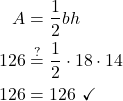9 Applications and Modeling
Topics Covered:[1]
Use a Problem-Solving Strategy for Word Problems
Have you ever had any negative experiences in the past with word problems? When we feel we have no control, and continue repeating negative thoughts, we set up barriers to success. Realize that your negative experiences with word problems are in your past. To move forward you need to calm your fears and change your negative feelings.
Now that we can solve equations, we are ready to apply our new skills to word problems. We will develop a strategy we can use to solve any word problem successfully.
- Read the problem. Make sure all the words and ideas are understood.
- Identify what you are looking for.
- Name what you are looking for. Choose a variable to represent that quantity.
- Translate into an equation. It may be helpful to restate the problem in one sentence with all the important information. Then, translate the English sentence into an algebra equation.
- Solve the equation using proper algebra techniques.
- Check the answer in the problem to make sure it makes sense.
- Answer the question with a complete sentence.
When dealing with real-world applications, there are certain expressions that we can translate directly into math. The table lists some common verbal expressions and their equivalent mathematical expressions.
| Verbal | Translation to Math Operations |
|---|---|
| One number exceeds another by a | x, x + a |
| Twice a number | 2x |
| One number is a more than another number | x, x + a |
| One number is a less than twice another number | x, 2x − a |
| The product of a number and a, decreased by b | ax − b |
| The quotient of a number and the number plus a is three times the number | |
| The product of three times a number and the number decreased by b is c | 3x(x − b) = c |
Try it!
Normal yearly snowfall at the local ski resort is 12 inches more than twice the amount it received last season. The normal yearly snowfall is 62 inches. What was the snowfall last season at the ski resort?
Solution (click to reveal)
| Steps | Algebraic |
| 1. Read the problem. | |
| 2. Identify what you are looking for. | What was the snowfall last season? |
| 3. Name what we are looking for and choose a variable to represent it. |
Let s = the snowfall last season. |
| 4. Translate. Restate the problem in one sentence with all the important information. |
|
| Translate into an equation. | |
| 5. Solve the equation. | |
| Subtract 12 from each side. | |
| Simplify. | |
| Divide each side by two. | |
| Simplify. | |
| 6. Check: | |
| First, is our answer reasonable? | Yes, having 25 inches of snow seems OK. |
| The problem says the normal snowfall is twelve inches more than twice the number of last season. | Twice 25 is 50 and 12 more than that is 62. |
| 7. Answer the question. | The snowfall last season was 25 inches. |
A married couple together earns $110,000 a year. The wife earns $16,000 less than twice what her husband earns. What does the husband earn?
Solution (click to reveal)
| Steps | Algebraic |
| 1. Read the problem. | |
| 2. Identify what you are looking for. | How much does the husband earn? |
| 3. Name.
Choose a variable to represent the amount the husband earns. |
Let h = the amount the husband earns. |
| The wife earns $16,000 less than twice her husband. | That is , 2h − 16,000 |
| 4. Translate.
Restate the problem in one sentence with all the important information. |
Together the husband and wife earn $110,000. |
| Translate into an equation. | |
| 5. Solve the equation. | |
| Combine like terms. | |
| Add 16,000 to both sides and simplify. | |
| Divide each side by three. | |
| 6. Interpret.
The amount husband earns |
h = $42,000 |
| The amount wife earns
|
2h − 16,000 2(42,000) − 16,000 84,000 − 16,000 $68,000 |
| 6. Check:
If the wife earns $68,000 and the husband earns $42,000, is that $110,000? |
Yes! because 68,000 + 42,000 = 110,000 |
| 7. Answer the question. | The husband earns $42,000 a year |
Access this online resource for additional instruction and practice with using a problem-solving strategy.
Solve Percent Applications
How many cents are in one dollar? There are 100 cents in a dollar. How many years are in a century? There are 100 years in a century. Does this give you a clue about what the word “percent” means? It is really two words, “per cent,” and means per one hundred. A percent is a ratio whose denominator is 100. We use the percent symbol %, to show percent.
A percent is a ratio whose denominator is 100.
Similarly, 25% means a ratio of ![]() , 3% means a ratio of
, 3% means a ratio of ![]() , and 100% means a ratio of
, and 100% means a ratio of ![]() . In words, “one hundred percent” means the total 100% is
. In words, “one hundred percent” means the total 100% is ![]() , and since
, and since ![]() , we see that 100% means 1 whole.
, we see that 100% means 1 whole.
There are several methods to solve percent equations. In algebra, it is easiest if we just translate English sentences into algebraic equations and then solve the equations. Be sure to change the given percent to a decimal before you use it in the equation.
How to convert a percent number to a decimal number
To convert a percent number to a decimal number, we move the decimal point two places to the left and remove the % sign. (Sometimes the decimal point does not appear in the percent number, but just like we can think of the integer 6 as 6.0, we can think of 6% as 6.0%. Notice that we may need to add zeros in front of the number when moving the decimal to the left.
- Write the percent as a ratio with the denominator 100.
- Convert the fraction to a decimal by dividing the numerator by the denominator.
Try it!
Convert each percent to a decimal:
a. 135%
b. 12.5%
Solution A (click to reveal)
a.
| Steps | Algebraic |
| Example | 135% |
| Write as a ratio with denominator 100. | |
| Change the fraction to a decimal by dividing the numerator by the denominator. | 1.35 |
Solution B (click to reveal)
b.
| Steps | Algebraic |
| Example | 12.5% |
| Write as a ratio with denominator 100. | |
| Change the fraction to a decimal by dividing the numerator by the denominator. | 0.125 |
Translate and solve:
a. What number is 45% of 84?
b. 8.5% of what amount is $4.76?
Solution A (click to reveal)
a.
| Steps | Algebraic |
| Example | What number is 45% of 84? |
| Translate into algebra. Let n = the number. |
|
| Multiply. |
|
| Solution | 37.8 is 45% of 84. |
Solution B (click to reveal)
b.
| Steps | Algebraic |
| Example | 8.5% of what amount is $4.76? |
| Translate. Let n = the amount. |
|
| Multiply.
Divide both sides by 0.085 and simplify. |
|
| Solution | 8.5% of $56 is $4.76 |
Now that we have a problem-solving strategy to refer to, and have practiced solving basic percent equations, we are ready to solve percent applications. Be sure to ask yourself if your final answer makes sense—since many of the applications we will solve involve everyday situations, you can rely on your own experience.
Try it!
The label on Audrey’s yogurt said that one serving provided 12 grams of protein, which is 24% of the recommended daily amount. What is the total recommended daily amount of protein?
Solution (click to reveal)
| Steps | Algebraic |
| What are you asked to find? | What total amount of protein is recommended? |
| Choose a variable to represent it. | Let a = total amount of protein. |
| Write a sentence that gives the information to find it. | 12g is 24% of the total amount |
| Translate into an equation. | |
| Solve. | |
|
|
|
| Check: Does this make sense? |
Yes, 24% is about |
|
And 12 is about |
|
| Write a complete sentence to answer the question. | The amount of protein that is recommended is 50g. |
Veronica is planning to make muffins from a mix. The package says each muffin will be 240 calories and 60 calories will be from fat. What percent of the total calories is from fat?
Solution (click to reveal)
| Steps | Algebraic |
| What are you asked to find? | What percent of the total calories is fat? |
| Choose a variable to represent it. | Let p = percent of fat. |
| Write a sentence that gives the information to find it. | What percent of 240 is 60? |
| Translate the sentence into an equation. | |
| Multiply. | |
| Divide both sides by 240. | |
| Put in percent form. | |
| Check: Does this make sense? | Yes, 25% is one-fourth; |
| 60 is one-fourth of 240. | |
| So, 25% makes sense. | |
| Write a complete sentence to answer the question. | Of the total calories in each muffin, 25% is fat. |
When you buy an item on sale, the original price has been discounted by some dollar amount. The discount rate, usually given as a percent, is used to determine the amount of the discount. To determine the amount of discount, we multiply the discount rate by the original price.
The price a retailer pays for an item is called the original cost. The retailer then adds a mark-up to the original cost to get the list price, the price he sells the item for. The mark-up is usually calculated as a percent of the original cost. To determine the amount of mark-up, multiply the mark-up rate by the original cost.
The sale price should always be less than the original price.
The list price should always be more than the original cost.
Try it!
Liam’s art gallery bought a painting at an original cost of $750. Liam marked the price up 40%. Find a. the amount of mark-up and b. the list price of the painting.
Solution A (click to reveal)
a.
| Steps | Algebraic |
| Identify what you are asked to find. | What is the amount of mark-up? |
| Choose a variable to represent it. | Let m = the amount of mark-up. |
| Write a sentence that gives the information to find it. | The mark-up is 40% of the $750 original cost |
| Translate into an equation. | |
| Solve the equation. | |
| Write a complete sentence. | The mark-up on the painting was $300. |
Solution B (click to reveal)
b.
| Steps | Algebraic |
| Identify what you are asked to find. | What is the list price? |
| Choose a variable to represent it. | Let p = the list price. |
| Write a sentence that gives the information to find it. |
The list price is original cost plus the mark-up |
| Translate into an equation. | |
| Solve the equation. | |
| Check.
Is the list price more than the original cost? |
Yes. |
| Write a complete sentence. | The list price of the painting was $1,050. |
Solve Simple Interest Applications
Interest is a part of our daily lives. From the interest earned on our savings to the interest we pay on a car loan or credit card debt, we all have some experience with interest in our lives.
The amount of money you initially deposit into a bank is called the principal, P, and the bank pays you interest, I. When you take out a loan, you pay interest on the amount you borrow, also called the principal.
In either case, the interest is computed as a certain percent of the principal, called the rate of interest, r. The rate of interest is usually expressed as a percent per year and is calculated by using the decimal equivalent of the percent. The variable t, (for time) represents the number of years the money is saved or borrowed.
Interest is calculated as simple interest or compound interest. Here we will use simple interest.
Simple Interest
If an amount of money, P, called the principal, is invested or borrowed for a period of t years at an annual interest rate r, the amount of interest, I. This is summarized in the table below.
| Formula | Definitions |
| I = Prt,
Where |
I = interest |
| P = principal | |
| r = rate | |
| t = time |
Interest earned or paid according to this formula is called simple interest.
The formula we use to calculate interest is I = Prt. To use the formula, we substitute in the values for variables that are given, and then solve for the unknown variable. It may be helpful to organize the information in a chart.
Try it!
Areli invested a principal of $950 in her bank account that earned simple interest at an interest rate of 3%. How much interest did she earn in five years?
Solution (click to reveal)
I = ?
P = $950
r = 3%
t = 5 years
| Steps | Algebraic |
| Identify what you are asked to find and choose a variable to represent it.
|
What is the simple interest?
Let I = interest. |
| Write the formula. | |
| Substitute in the given information. | |
| Simplify. | |
| Check.
Is $142.50 a reasonable amount of interest on $950? |
Yes. |
| Write a complete sentence. | The interest is $142.50. |
There may be times when we know the amount of interest earned on a given principal over a certain length of time, but we do not know the rate.
Try it!
Hang borrowed $7,500 from her parents to pay her tuition. In five years, she paid them $1,500 interest in addition to the $7,500 she borrowed. What was the rate of simple interest?
Solution (click to reveal)
I = $1500
P = $7500
r = ?
t = 5 years
| Steps | Algebraic |
| Identify what you are asked to find. | What is the rate of simple interest? |
| Choose a variable to represent it. | Let r = rate of interest. |
| Write the formula. | |
| Substitute in the given information. | |
| Simplify | |
| Divide both sides by 37,500 | |
| Simplify | |
| Check. |
|
| Write a complete sentence. | The rate of interest was 4%. |
In the next example, we are asked to find the principal—the amount borrowed.
Try it!
Sean’s new car loan statement said he would pay $4,866.25 in interest from a simple interest rate of 8.5% over five years. How much did he borrow to buy his new car?
Solution (click to reveal)
I = 4,866.25
P = ?
r = 8.5%
t = 5 years
| Steps | Algebraic |
| Identify what you are asked to find and choose a variable to represent it. | What is the amount borrowed (the principal)?
Let P = principal borrowed. |
| Write the formula. | |
| Substitute in the given information. | |
| Multiply. | |
| Divide. | |
| Check. |
|
| Write a complete sentence. | The principal was $11,450. |
Geometry Applications
In this objective we will use some common geometry formulas. We will adapt our problem-solving strategy so that we can solve geometry applications. The geometry formula will name the variables and give us the equation to solve.
In addition, since these applications will all involve shapes of some sort, most people find it helpful to draw a figure and label it with the given information. We will include this in the first step of the problem-solving strategy for geometry applications.
When we solve geometry applications, we often have to use some of the properties of the figures. We will review those properties as needed.
The next example involves the area of a triangle. The area of a triangle is one-half the base times the height. We can write this as ![]() , where b = length of the base and h = height.
, where b = length of the base and h = height.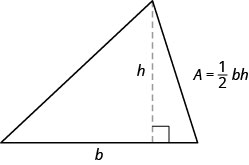
Try it!
The area of a triangular painting is 126 square inches. The base is 18 inches. What is the height?
Solution (click to reveal)
| Steps | Algebraic |
| 1. Read the problem. | |
| 2. Identify what you are looking for. | height of a triangle |
| 3. Name. Choose a variable to represent it. |
Let h = the height, Area = 126 sq. in. |
| Draw the figure and label it with the given information. | 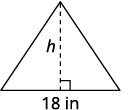 |
| 4. Translate.
Write the appropriate formula. |
|
| Substitute in the given information. | |
| 5. Solve the equation. | |
| Divide both sides by 9. | |
| 6. Check.
|
|
| 7. Answer the question. | The height of the triangle is 14 inches. |
In the next example, we will work with a right triangle. To solve for the measure of each angle, we need to use two triangle properties. In any triangle, the sum of the measures of the angles is 180°. We can write this as a formula: m ∠ A + m ∠ B + m ∠ C = 180. Also, since the triangle is a right triangle, we remember that a right triangle has one 90° angle.
Here, we will have to define one angle in terms of another. We will wait to draw the figure until we write expressions for all the angles we are looking for.
Try it!
The measure of one angle of a right triangle is 40 degrees more than the measure of the smallest angle. Find the measures of all three angles.
Solution (click to reveal)
| Steps | Algebraic |
| 1. Read the problem. | |
| 2. Identify what you are looking for. | the measures of all three angles |
| 3. Name.
Choose a variable to represent it.
|
Let a = 1st angle, a + 40 = 2nd angle, 90 = 3rd angle (the right angle). |
| Draw the figure and label it with the given information. | 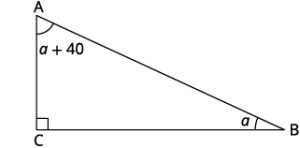 |
| 4. Translate.
Write the appropriate formula. |
|
| Substitute into the formula. | |
| 5. Solve the equation.
|
|
| First angle | |
| Second angle | |
| Third angle | |
| 6. Check.
|
|
| 7. Answer the question. | The three angles measure 25°, 65°, and 90°. |
The next example uses another important geometry formula. The Pythagorean Theorem tells how the lengths of the three sides of a right triangle relate to each other. Writing the formula in every exercise and saying it aloud as you write it may help you memorize the Pythagorean Theorem.
In any right triangle, where a and b are the lengths of the legs, and c is the length of the hypotenuse, the sum of the squares of the lengths of the two legs equals the square of the length of the hypotenuse.
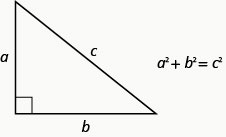
Try it!
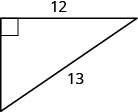
Solution (click to reveal)
| Steps | Algebraic |
| 1. Read the problem. | |
| 2. Identify what you are looking for. | the length of the leg of the triangle |
| 3. Name.
Choose a variable to represent it. |
Let a = the leg of the triangle. |
| Label side a. | 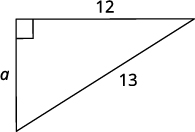 |
| 4. Translate.
Write the appropriate formula. |
|
| Substitute. | |
| 5. Solve the equation. | |
| Isolate the variable term. | |
| Use the definition of square root. | |
| Simplify. | |
| 6. Check. |
|
| 7. Answer the question. | The length of the leg is 5. |
The next example is about the perimeter of a rectangle. Since the perimeter is just the distance around the rectangle, we find the sum of the lengths of its four sides—the sum of two lengths and two widths. We can write is as P = 2L + 2W where L is the length and W is the width. To solve the example, we will need to define the length in terms of the width.
Try it!
The length of a rectangle is six centimeters more than twice the width. The perimeter is 96 centimeters. Find the length and width.
Solution (click to reveal)
| Steps | Algebraic |
| 1. Read the problem. | |
| 2. Identify what we are looking for. | the length and the width |
| 3. Name.
Choose a variable to represent the width. |
Let w = width |
| The length is six more than twice the width.
|
Length = 2w + 6 ,
P = 96cm.
|
| 4. Translate.
Write the appropriate formula. |
|
| Substitute in the given information. | |
| 5. Solve the equation. | |
| Combine like terms | |
| Subtract 12 from both sides | |
| Width | |
| Length | |
6. Check. |
|
| 7. Answer the question. | The length is 34cm and the width is 14cm. |
The next example is about the perimeter of a triangle. Since the perimeter is just the distance around the triangle, we find the sum of the lengths of its three sides. We can write this as ![]() , where a, b, and c are the lengths of the sides.
, where a, b, and c are the lengths of the sides.
Try it!
One side of a triangle is three inches more than the first side. The third side is two inches more than twice the first. The perimeter is 29 inches. Find the length of the three sides of the triangle.
Solution (click to reveal)
| Steps | Algebraic |
| 1. Read the problem. | |
| 2. Identify what we are looking for. | the lengths of the three sides of a triangle |
| 3. Name.
Choose a variable to represent the length of the first side.
|
Let x = length of 1st side, x + 3 = length of 2nd side, 2x + 2 = length of 3rd side.
|
| 4. Translate.
Write the appropriate formula. |
|
| Substitute in the given information. | |
| 5. Solve the equation. | |
| Subtract 5 from both sides | |
| Length of first side | |
| Length of second side | |
| Length of third side | |
6. Check. |
|
| 7. Answer the question. | The lengths of the sides of the triangle are 6, 9, and 14 inches. |
The perimeter of a rectangular soccer field is 360 feet. The length is 40 feet more than the width. Find the length and width.
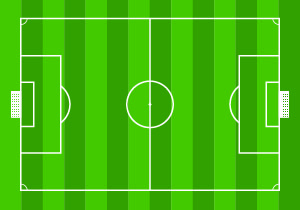
Solution (click to reveal)
| Steps | Algebraic |
| 1. Read the problem. | |
| 2. Identify what we are looking for. | the length and width of the soccer field |
| 3. Name.
Choose a variable to represent it. |
Let w = width |
| The length is 40 feet more than the width. | Length = w + 40 |
| Draw the figure and label it with the given information. | 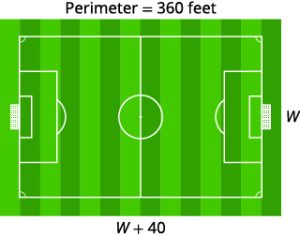 |
| 4. Translate
Write the appropriate formula. |
|
| Substitute the given information. | |
| 5. Solve the equation. | |
| Combine like terms | |
| Subtract 80 from both sides | |
| The width of the field | |
| The length of the field | |
| 6. Check.
|
|
| 7. Answer the question. | The length of the soccer field is 110 feet and the width is 70 feet. |
Applications of these geometric properties can be found in many everyday situations as shown in the next example.
Try it!
Kelvin is building a gazebo and wants to brace each corner by placing a 10” piece of wood diagonally as shown.
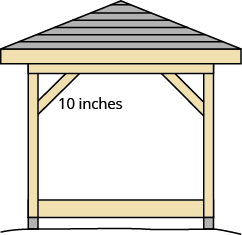 How far from the corner should he fasten the wood if he wants the distances from the corner to be equal? Approximate to the nearest tenth of an inch.
How far from the corner should he fasten the wood if he wants the distances from the corner to be equal? Approximate to the nearest tenth of an inch.
Solution (click to reveal)
| Steps | Algebraic |
| 1. Read the problem. | |
| 2. Identify what we are looking for. | the distance from the corner that the bracket should be attached |
| 3. Name.
Choose a variable to represent it. |
Let x = the distance from the corner. |
| Draw the figure and label it with the given information. | 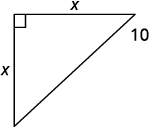 |
| 4. Translate.
Write the appropriate formula |
|
| Substitute the given information. | |
| 5. Solve the equation. | |
| Isolate the variable. | |
| Use the definition of square root. | |
| Simplify. Approximate to the nearest tenth. | |
| 6. Check. |
|
| 7. Answer the question. | Kelvin should fasten each piece of wood approximately 7.1 feet from the corner. |
Access this online resource for additional instruction and practice with solving for a variable in literal equations.
Solve Formulas for One Variable
We have all probably worked with some geometric formulas in our study of mathematics. Formulas are used in so many fields, it is important to recognize formulas and be able to manipulate them easily.
It is often helpful to solve a formula for a specific variable. If you need to put a formula in a spreadsheet, it is not unusual to have to solve it for a specific variable first. We isolate that variable on one side of the equals sign with a coefficient of one and all other variables and constants are on the other side of the equal sign.
Geometric formulas often need to be solved for another variable, too. The formula ![]() is used to find the volume of a right circular cone when given the radius of the base and height. In the next example, we will solve this formula for the height.
is used to find the volume of a right circular cone when given the radius of the base and height. In the next example, we will solve this formula for the height.
Try it!
Solve the formula ![]() for h.
for h.
Solution (click to reveal)
| Steps | Algebraic |
| Write the formula. | |
| Remove the fraction on the right. | |
| Simplify. | |
| Divide both sides by |
We could now use this formula to find the height of a right circular cone when we know the volume and the radius of the base, by using the formula ![]() .
.
In the sciences, we often need to change temperature from Fahrenheit to Celsius or vice versa. If you travel in a foreign country, you may want to change the Celsius temperature to the more familiar Fahrenheit temperature.
Try it!
Solve the formula ![]() for F.
for F.
Solution (click to reveal)
| Steps | Algebraic |
| Write the formula. | |
| Remove the fraction on the right. | |
| Simplify. | |
| Add 32 to both sides. |
We can now use the formula ![]() to find the Fahrenheit temperature when we know the Celsius temperature.
to find the Fahrenheit temperature when we know the Celsius temperature.
The next example uses the formula for the surface area of a right cylinder.
Try it!
Solve the formula ![]() for h.
for h.
Solution (click to reveal)
| Steps | Algebraic |
| Write the formula. | |
| Isolate the h term by subtracting |
|
| Simplify. | |
| Solve for h by dividing both sides by |
|
| Simplify. |
Key Concepts
- How To Use a Problem-Solving Strategy for Word Problems
- Read the problem. Make sure all the words and ideas are understood.
- Identify what you are looking for.
- Name what you are looking for. Choose a variable to represent that quantity.
- Translate into an equation. It may be helpful to restate the problem in one sentence with all the important information. Then, translate the English sentence into an algebra equation.
- Solve the equation using proper algebra techniques.
- Check the answer in the problem to make sure it makes sense.
- Answer the question with a complete sentence.
- How To Find Percent Change
- Find the amount of change
change = new amount − original amount - Find what percent the amount of change is of the original amount.
change is what percent of the original amount?
- Find the amount of change
- Discount
amount of discount = discount rate original price
original price
sale price = original amount − discount
- Mark-up
amount of mark-up = mark-up rate original cost
original cost
list price = original cost + mark up
- Simple Interest
If an amount of money, P, called the principal, is invested or borrowed for a period of t years at an annual interest rate r, the amount of interest, I, earned or paid. This is summarized in the table below.
| Formula | Definitions |
| I = Prt, where |
I = interest |
| P = principal | |
| r = rate | |
| t = time |
- derived from Openstax Intermediate Algebra, Access for free at https://openstax.org/books/intermediate-algebra-2e/pages/1-introduction. Pre-Algebra, Access for free at https://openstax.org/books/prealgebra-2e/pages/1-introduction ↵
Topics Covered:[1]
Recognize the Graph of a Quadratic Function[2]
Previously we very briefly looked at the function [latex]\displaystyle f(x) = x^2[/latex], which we called the square function. It was one of the first non-linear functions we looked at. Now we will graph functions of the form [latex]\displaystyle f(x) = a x^2+ bx + c[/latex] if [latex]\displaystyle a\ne 0[/latex]. We call this kind of function a quadratic function.
Quadratic Function
A quadratic function, where a, b, and c are real numbers and [latex]\displaystyle a\ne 0[/latex], is a function of the form
We graphed the quadratic function [latex]\displaystyle f(x) = x^2[/latex] by plotting points.
| x | f(x) = x2 | (x , f(x)) |
| -3 | 9 | (-3, 9) |
| -2 | 4 | (-2, 4) |
| -1 | 1 | (-1, 1) |
| 0 | 0 | (0, 0) |
| 1 | 1 | (1, 1) |
| 2 | 4 | (2, 4) |
| 3 | 9 | (3, 9) |
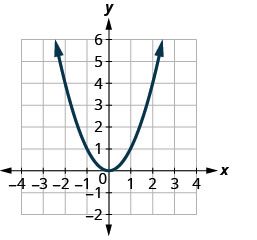
Every quadratic function has a graph that looks like this. We call this figure a parabola. Let’s practice graphing a parabola by plotting a few points.
Try it!
Graph [latex]\displaystyle f(x)=x^2 - 1[/latex]
Solution (click to reveal)
We will graph the function by plotting points.
Step 1: Choose integer values for x, substitute them into the equation and simplify to find [latex]\displaystyle f(x)[/latex]. Record the values of the ordered pairs in the chart.
| x | f(x) |
| 0 | -1 |
| 1 | 0 |
| -1 | 0 |
| 2 | 3 |
| 2 | 3 |
Step 2: Plot the points, and then connect them with a smooth curve. The result will be the graph of the function [latex]\displaystyle f(x)=x^2 - 1[/latex]
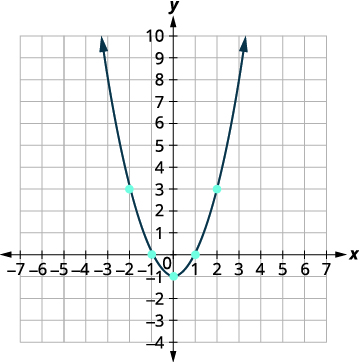
Graph [latex] f(x) = -x^2[/latex].
Solution (click to reveal)
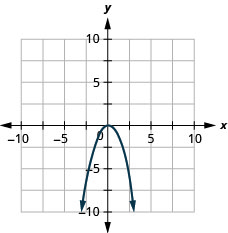
The graph of a quadratic function is a U-shaped curve called a parabola. One important feature of the graph is that it has an extreme point called the vertex. If the parabola opens up, the vertex represents the lowest point on the graph or the minimum value of the quadratic function. If the parabola opens down, the vertex represents the highest point on the graph or the maximum value. In either case, the vertex is a turning point on the graph. The graph is also symmetric with a vertical line drawn through the vertex, called the axis of symmetry. These features are illustrated in the graph below.
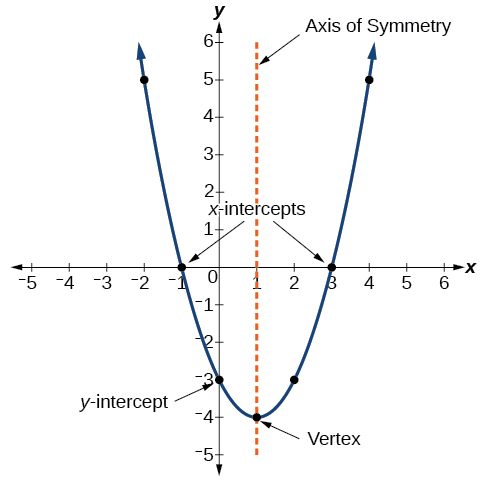
The y-intercept is the point at which the parabola crosses the y-axis. The x-intercepts are the points at which the parabola crosses the x-axis. If they exist, the x-intercepts represent the zeros, or roots of the quadratic function, the values of x at which y = 0.
Try it! - Identifying the Characteristics of a Parabola
Determine the vertex, axis of symmetry, zeros, and y-intercept of the parabola shown in the graph below.
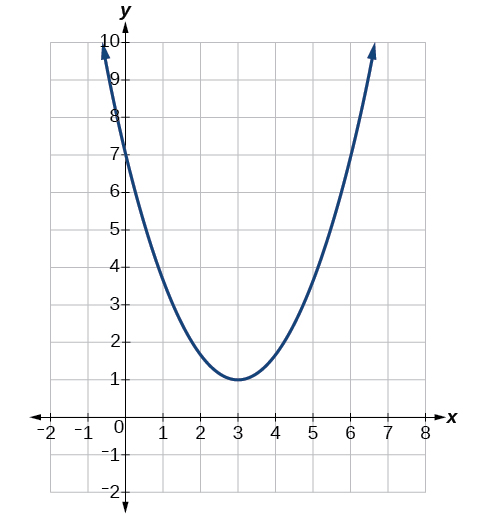
Solution (click to reveal)
The vertex is the turning point of the graph. We can see that the vertex is at (3, 1). Because this parabola opens upward, the vertex is a minimum point. The axis of symmetry is the vertical line that intersects the parabola at the vertex. So the axis of symmetry is x = 3. This parabola does not cross the x-axis, so it has no zeros. It crosses the y-axis at (0, 7), so, this is the y-intercept.
All graphs of quadratic functions of the form f(x) = ax2 + bx + c are parabolas that open upward or downward, as shown in the graph below.
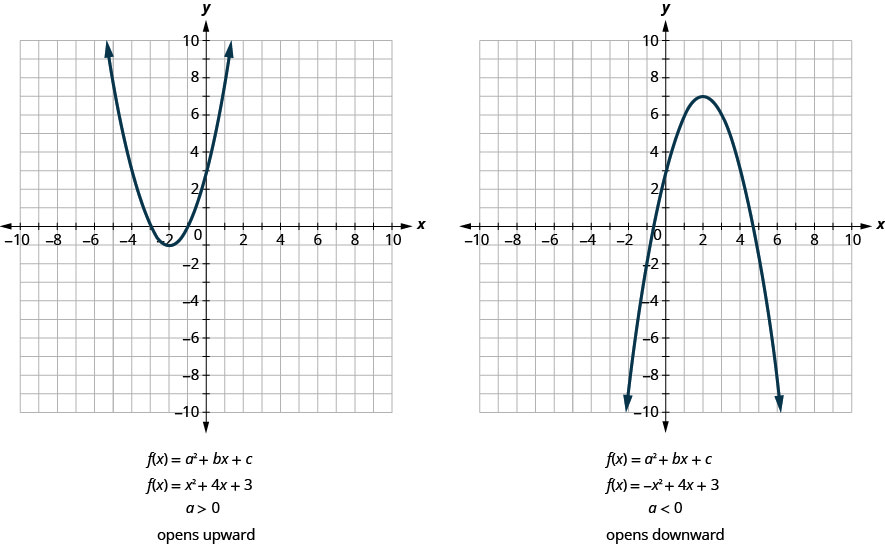
Notice that the only difference in the two functions is the negative sign before the quadratic term (x2 in the equation of the graph above). When the quadratic term is positive, the parabola opens upward, and when the quadratic term is negative, the parabola opens downward.
Parabola Orientation
For the graph of the quadratic function f (x) = ax2 + bx + c, if:
a > 0, the parabola opens upward![]()
a < 0, the parabola opens downward ![]()
Try it!
Determine whether each parabola opens upward or downward:
a. [latex]\displaystyle f(x) = -3x^2 + 2x - 4[/latex]
b. [latex]\displaystyle f(x) = 6x^2 + 7x - 9[/latex].
Solution A (click to reveal)
a.
| Steps | Algebraic |
| Find the value of “a”. | [latex]\begin{align*} f(x) &= {\color{myred1}ax^2 + bx + c} \\ f(x) &= -3x^2 + 2x -4 \\ a &= -3 \end{align*}[/latex] |
| Solution | Since the “a” is negative, the parabola will open downward. |
Solution B (click to reveal)
b.
| Steps | Algebraic |
| Find the value of “a”. | [latex]\begin{align*} f(x) &= {\color{myred1}ax^2 + bx + c} \\ f(x) &= 6x^2 + 7x - 9 \\ a &= 6 \end{align*}[/latex] |
| Solution | Since the “a” is positive, the parabola will open upward. |
2. Determine whether the graph of each function is a parabola that opens upward or downward:
a. [latex]\displaystyle f(x) = 2x^2 + 5x - 2[/latex]
b. [latex]\displaystyle f(x) = -3x^2 - 4x + 7[/latex].
Solution (click to reveal)
a. up
b. down
Find the Axis of Symmetry and Vertex of a Parabola
We will be looking at 2 forms of the quadratic function. The general form of a quadratic function presents the function in the form
f(x) = ax2 + bx +c
where a, b, and c are real numbers and a ≠ 0. If a > 0, the parabola opens upward. If a < 0, the parabola opens downward. We can use the general form of a parabola to find the equation for the axis of symmetry.
Look again at the previous graph. Do you see that we could fold each parabola in half and then one side would lie on top of the other? The ‘fold line’ is a line of symmetry. We call it the axis of symmetry of the parabola.
We show the same two graphs again with the axis of symmetry below.
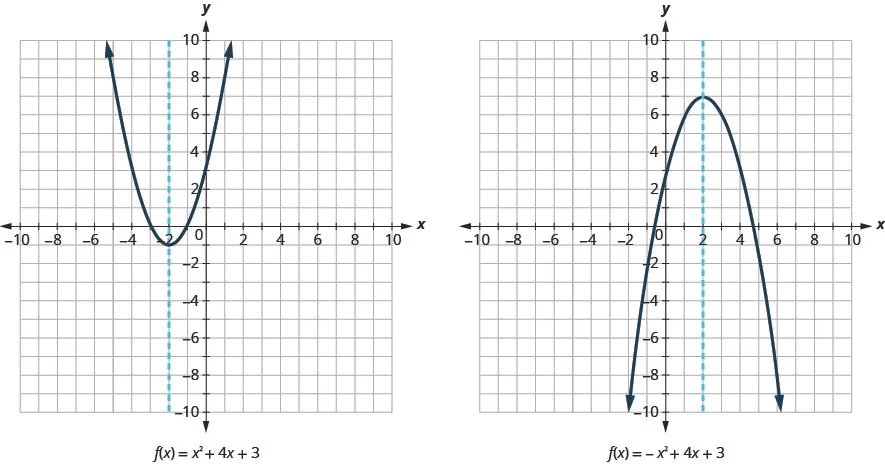
The axis of symmetry is defined by [latex]\displaystyle x= -\frac{b}{2a}[/latex]. If we use the quadratic formula, [latex]\displaystyle x= \frac{-b\pm\sqrt{b^2−-4ac}}{2a}[/latex], to solve ax2 + bx + c = 0 for the x-intercepts or zeros, we find the value of x halfway between them is always [latex]\displaystyle x = -\frac{b}{2a}[/latex], the equation for the axis of symmetry.
So to find the equation of symmetry of each of the parabolas we graphed above, we will substitute into the formula [latex]\displaystyle x = -\frac{b}{2a}[/latex].
| Steps | a >0 Example | a < 0 Example |
| Quadratic form | [latex]\displaystyle f(x) = ax^2 + bx + c[/latex] | [latex]\displaystyle f(x) = ax^2 + bx + c[/latex] |
| Starting Equation | [latex]\displaystyle f(x) = x^2 + 4x + 3[/latex] | [latex]\displaystyle f(x) = -x^2 + 4x + 3[/latex] |
| Axis of Symmetry equation | The axis of symmetry is defined by [latex]\displaystyle x= -\frac{b}{2a}[/latex] | The axis of symmetry is defined by [latex]\displaystyle x= -\frac{b}{2a}[/latex] |
| Plug in the values for a & b into the equation | [latex]\displaystyle x= -\frac{4}{2.1}[/latex] | [latex]\displaystyle x= -\frac{4}{2{(-1)}}[/latex] |
| Simplify | [latex]\displaystyle x= -2[/latex] | [latex]\displaystyle x= 2[/latex] |
Notice that these are the equations of the dashed blue lines on the graphs.
The point on the parabola that is the lowest (parabola opens up), or the highest (parabola opens down), lies on the axis of symmetry. This point is called the vertex of the parabola.
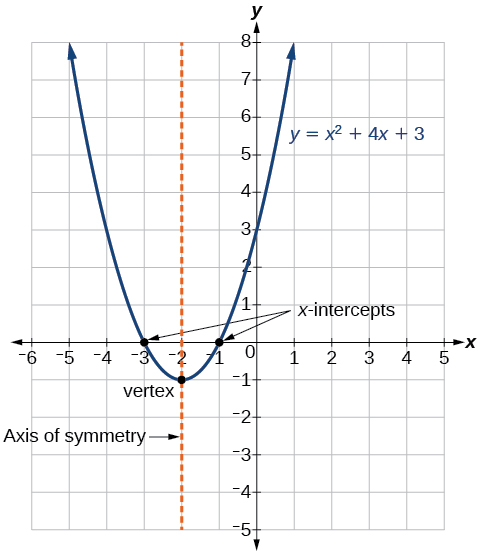 We can easily find the coordinates of the vertex because we know it is on the axis of symmetry. This means its x-coordinate is [latex]\displaystyle x = -\frac{b}{2a}[/latex]. To find the y-coordinate of the vertex we substitute the value of the x-coordinate into the quadratic function, as shown in the table below.
We can easily find the coordinates of the vertex because we know it is on the axis of symmetry. This means its x-coordinate is [latex]\displaystyle x = -\frac{b}{2a}[/latex]. To find the y-coordinate of the vertex we substitute the value of the x-coordinate into the quadratic function, as shown in the table below.
| Steps | a >0 Example | a < 0 Example |
| Starting Equation | [latex]\displaystyle f(x) = x^2 + 4x + 3[/latex] | [latex]\displaystyle f(x) = -x^2 + 4x + 3[/latex] |
| Axis of Symmetry (see previous table above) | The axis of symmetry is [latex]\displaystyle x= {\color{myred1}-2}[/latex] | The axis of symmetry is [latex]\displaystyle x= {\color{myred1}2}[/latex] |
| Vertex x-coordinate | The vertex is [latex]\displaystyle({\color{myred1}-2}, \_)[/latex] | The vertex is [latex]\displaystyle({\color{myred1}2}, \_)[/latex] |
| Repeat equation to find the y-coordinate | [latex]\displaystyle f(x) = x^2 + 4x + 3[/latex] | [latex]\displaystyle f(x) = -x^2 + 4x + 3[/latex] |
| Plug in Vertex x-coordinate | [latex]\displaystyle f(x) = ({\color{myred1}-2})^2 + 4({\color{myred1}-2}) + 3[/latex] | [latex]\displaystyle f(x) = -({\color{myred1}2})^2 + 4({\color{myred1}2}) + 3[/latex] |
| Simplify | [latex]\displaystyle f(x) = -1[/latex] | [latex]\displaystyle f(x) = 7[/latex] |
| Solution | The vertex is [latex]\displaystyle(-2, -1)[/latex] | The vertex is [latex]\displaystyle(-2, 7)[/latex] |
Axis of Symmetry and Vertex of a Parabola
The graph of the function f (x) = ax2 + bx + c is a parabola where:
- the axis of symmetry is the vertical line [latex]\displaystyle x = -\frac{b}{2a}[/latex].
- the vertex is a point on the axis of symmetry, so its x-coordinate is [latex]\displaystyle \frac{b}{2a}[/latex].
- the y-coordinate of the vertex is found by substituting [latex]\displaystyle x = -\frac{b}{2a}[/latex] into the quadratic equation.
Try it!
For the graph of f(x) = 3x2 − 6x + 2, find:
a. the axis of symmetry
b. the vertex.
Solution A (click to reveal)
a.
| Steps | Algebraic |
| Equation | [latex]\begin{align*} f(x) &= {\color{myred1}ax^2 + bx + c }\\ f(x) &= 3x^2 - 6x + 2 \end{align*}[/latex] |
| The axis of symmetry is the vertical line [latex]\displaystyle x= -\frac{b}{2a}[/latex].
Substitute the values of a, b into the equation. |
[latex]\displaystyle x = -\frac{-6}{2.3}[/latex] |
| Simplify. | [latex]\displaystyle x = 1[/latex] |
| Solution | The axis of symmetry is the line x = 1. |
Solution B (click to reveal)
b.
| Steps | Algebraic |
| Equation | [latex]\begin{align*} f(x) &= {\color{myred1}ax^2 + bx + c }\\ f(x) &= 3x^2 - 6x + 2 \end{align*}[/latex] |
| The vertex is a point on the line of symmetry, so its x-coordinate will be [latex] \displaystyle x= 1 [/latex].
Find f(1). |
[latex]\displaystyle f(x) = 3{(1)}^2 - 6{(1)} + 2[/latex] |
| Simplify. | [latex]\displaystyle f(x) = 3 . 1 - 6 + 2[/latex] |
| The result is the y-coordinate. | [latex]\displaystyle f(x) = -1[/latex] |
| Solution |
The vertex is (1, -1). |
For the graph of f(x) = 2x2 − 8x + 1, find:
a. the axis of symmetry
b. the vertex.
Solution (click to reveal)
a. x = 2
b. (2, −7)
Earlier in the chapter we mentioned we will see 2 forms of the quadratic function. We have already looked at the general form of the quadratic function; the second form is the Standard form (also called the Vertex form). The standard form of a quadratic function presents the function in the form
where(h, k) is the vertex. Because the vertex appears in the standard form of the quadratic function, this form is also known as the vertex form of a quadratic function.
As with the general form, if a > 0, the parabola opens upward, and the vertex is a minimum. If a < 0, the parabola opens downward, and the vertex is a maximum. The graph below represents the graph of the quadratic function written in standard form as y = -3(x + 2)2 + 4. Since x - h = x + 2 in this example, h = -2. In this form, a = -3, h = -2, and k = 4. Because a < 0, the parabola opens downward. The vertex is at (−2, 4).
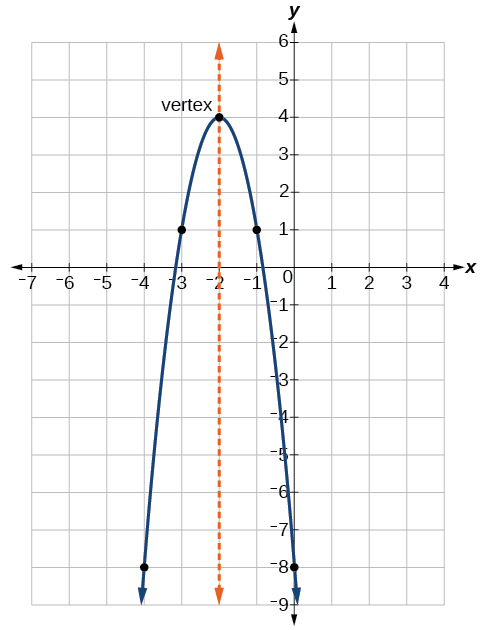
The standard form is useful for determining how the graph is transformed from the graph of y = x2. The graph shown below is that of this basic function.
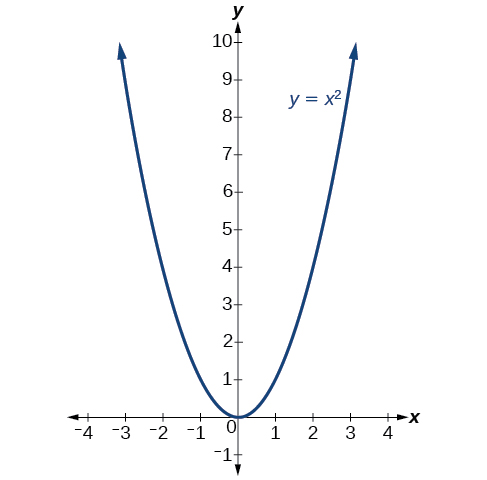
The standard form and the general form are equivalent methods of describing the same function. We can see this by expanding out the general form and setting it equal to the standard form.
For the linear terms to be equal, the coefficients must be equal.
[latex]\displaystyle -2ah = b, \quad \text{ so }\quad h = - \frac{b}{2a}[/latex]
This is the axis of symmetry we defined earlier. Setting the constant terms equal:
[latex]\begin{align*} ah^2 + k &= c \\ k &= c - ah^2\\ &= c - a - \left(\frac{b}{2a}\right)^2\\ &= c - \frac{b^2}{4a} \end{align*}[/latex]
In practice, though, it is usually easier to remember that k is the output value of the function when the input is h, so f(h) = k.
Forms of Quadratic Functions
A quadratic function is a polynomial function of degree two. The graph of a quadratic function is a parabola.
The general form of a quadratic function is f(x) = ax2 + bx + c where a, b, and c are real numbers and a ≠ 0.
The standard form of a quadratic function is f(x) = a(x − h)2 + k where a ≠ 0.
The vertex (h, k) is located at
How to find the vertex of the parabola, given a quadratic function.
- Identify a, b, and c.
- Find h, the x-coordinate of the vertex, by substituting a and b into [latex]\displaystyle h = - \frac{b}{2a}[/latex].
- Find k, the y-coordinate of the vertex, by evaluating [latex] \displaystyle k = f(h) = f \left(-\frac{b}{2a}\right)[/latex].
Try it! - Finding the Vertex of a Quadratic Function
Find the vertex of the quadratic function f(x) = 2x2 – 6x + 7. Rewrite the quadratic in standard form (vertex form).
Solution (click to reveal)
The horizontal coordinate of the vertex will be at
[latex]\begin{align*} h &= - \frac{b}{2a}\\ &= - \frac{-6}{2(2)}\\ &= \frac{6}{4}\\ &= \frac{3}{2} \end{align*}[/latex]
The vertical coordinate of the vertex will be at
[latex]\begin{align*} k &= f(h)\\ &= f\left(\frac{3}{2}\right) \\ &= 2\left(\frac{3}{2}\right) ^2 - 6\left(\frac{3}{2}\right) + 7 \\
&= \frac{5}{2} \end{align*}[/latex]
Rewriting into standard form, the stretch factor will be the same as the a in the original quadratic. First, find the horizontal coordinate of the vertex. Then find the vertical coordinate of the vertex. Substitute the values into standard form, using the "a" from the general form.
The standard form of a quadratic function prior to writing the function then becomes the following:
Given the equation g(x) = 13 + x2 − 6x, write the equation in general form and then in standard form.
Solution (click to reveal)
g(x) = x2 − 6x + 13 in general form; g(x) = (x − 3)2 + 4 in standard form
Find the Intercepts of a Parabola
When we graphed linear equations, we often used the x- and y-intercepts to help us graph the lines. Finding the coordinates of the intercepts will help us to graph parabolas, too.
Remember, at the y-intercept the value of x is zero. So to find the y-intercept, we substitute x = 0 into the function.
Let’s find the y-intercepts of the two parabolas shown in the graph below.
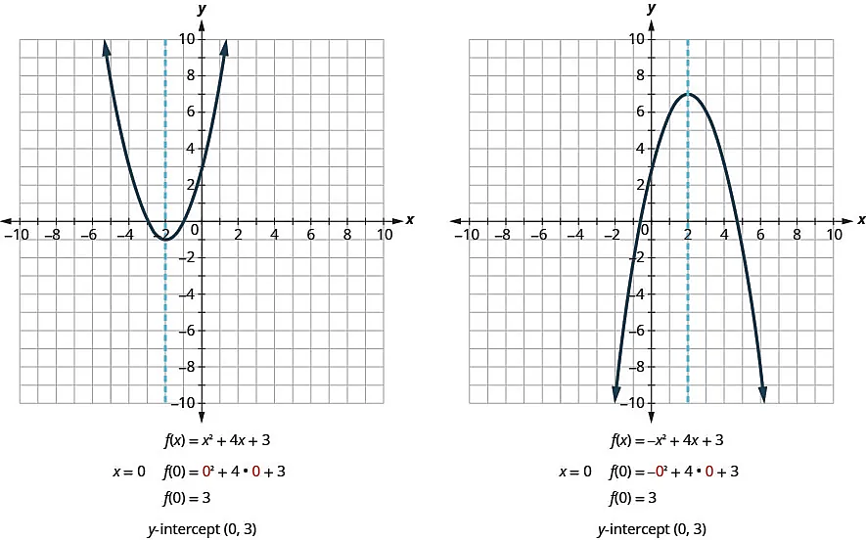
An x-intercept results when the value of f(x) is zero. To find an x-intercept, we let f(x) = 0. In other words, we will need to solve the equation 0 = ax2 + bx + c for x.
Solving quadratic equations like this is exactly what we have done earlier in this chapter!
We can now find the x-intercepts of the two parabolas we looked at. First we will find the x-intercepts of the parabola whose function is f (x) = x2 + 4x + 3.
| Steps | Algebraic |
| Function | [latex]\displaystyle f(x) = x^2 + 4x + 3[/latex] |
| Let f(x) = 0, as indicated in red. | [latex]\displaystyle {\color{myred1}0} = x^2 + 4x + 3[/latex] |
| Factor. | [latex]\displaystyle 0 = {(x + 1)} {(x + 3)}[/latex] |
| Use the Zero Product Property. | [latex]\begin{align*} {x + 1} &= 0 \\ {x + 3} &= 0 \end{align*}[/latex] |
| Solve. | [latex]\begin{align*} x &= -1 \\ x &= -3 \end{align*}[/latex] |
| Solution | The x-intercepts are (−1, 0) and (−3, 0). |
Now we will find the x-intercepts of the parabola whose function is f (x) = -x2 + 4x + 3.
| Steps | Algebraic |
| Function | [latex]\displaystyle f(x) = -x^2 + 4x + 3[/latex] |
| Let f(x) = 0, as indicated in red. | [latex]\displaystyle {\color{myred1} 0} = -x^2 + 4x + 3[/latex] |
| This quadratic does not factor, so we use the Quadratic Formula. | [latex]\displaystyle x= \frac{-b\pm\sqrt{b^2−-4ac}}{2a}[/latex] |
| Substitute a = −1, b = 4, c = 3 | [latex]\displaystyle x= \frac{-4\pm\sqrt{4^2−-4(-1)(2)}}{2(-1)}[/latex] |
| Simplify | [latex]\begin{align*} x &= \frac{-4 \pm \sqrt{28}}{-2} \\ x &= \frac{-4 \pm 2\sqrt{7}}{-2} \\ x &= \frac{-2(2 \pm \sqrt{7})}{-2} \\ x &= 2 \pm \sqrt{7} \end{align*}[/latex] |
| Solution | The x-intercepts are [latex]\displaystyle (2 + \sqrt{7}, 0)[/latex] and [latex]\displaystyle (2 - \sqrt{7}, 0)[/latex]. |
We will use the decimal approximations of the x-intercepts so that we can locate these points on the graph,
Do these results agree with our graphs? See the graphs below.
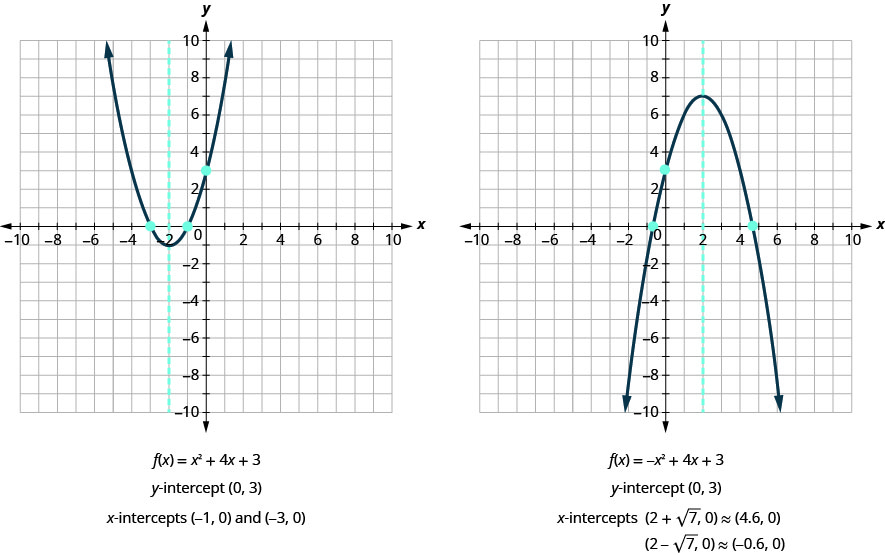
Find the Intercepts of a Parabola
To find the intercepts of a parabola whose function is f(x) = ax2 + bx + c:
| y-intercept | x-intercepts |
| Let x = 0 and solve for f(x). | Let f(x) = 0 and solve for x. |
Try it!
Find the intercepts of the parabola whose function is f(x) = x2 − 2x − 8.
Solution (click to reveal)
| Steps | Algebraic |
| To find the y-intercept, | [latex]\displaystyle f(x) = x^2 - 2x - 8[/latex] |
| let x = 0, as indicated in red. | [latex]\displaystyle f(0) = {\color{myred1}0}^2 - 2({\color{myred1}0}) - 8[/latex] |
| and solve for f(x) | [latex]\displaystyle 0 = - 8[/latex] |
| When x = 0, then f(0) = −8. | The y-intercept is the point (0, −8). |
| To find the x-intercept, | [latex]\displaystyle f(x) = x^2 - 2x - 8[/latex] |
| Set equal to zero | [latex]\displaystyle 0 = x^2 - 2x - 8[/latex] |
| Solve by factoring. | [latex]\displaystyle 0 = {(x - 4)} {(x + 2)}[/latex] |
| Set each factor to zero and solve | [latex]\begin{align*} 0 &= x -4 \\ 0 &= x + 2 \end{align*}[/latex] |
| Solution | [latex]\begin{align*} 4 &= x \\ -2 &= x \end{align*}[/latex] |
| When f(x) = 0, then x = 4 or x = −2. | The x-intercepts are the points (4, 0) and (−2, 0). |
Find the intercepts of the parabola whose function is f(x) = x2 − 4x − 12.
Solution (click to reveal)
y-intercept: (0, −12) x-intercepts (−2, 0), (6, 0)
In this chapter, we have been looking at quadratic functions of the form f(x) = ax2 + bx + c. The graphs of these functions are parabolas. The x-intercepts of the parabolas occur where f(x) = 0.
Let's compare the quadratic equation to the quadratic function for comparison. For example:
| Quadratic equation | Steps | Quadratic function |
| x2 − 2x − 15 = 0 | Equation / Function |
f(x) = x2 − 2x − 15 |
| x2 − 2x − 15 = 0 | Let f(x) = 0 on the function to the right. | 0 = x2 − 2x − 15 |
| (x − 5) (x + 3) = 0 | Factor the equations | 0 = (x − 5) (x + 3) |
| x − 5 = 0 x + 3 = 0 | Simplify | x − 5 = 0 x + 3 = 0 |
| x = 5 x = −3 | Solution | x = 5 x = −3 |
| No further steps | For the function, we represent these as the x-intercepts. |
(5, 0) and (−3, 0) x-intercepts |
The solutions of the quadratic function are the x values of the x-intercepts.
Earlier, we saw that quadratic equations have 2, 1, or 0 solutions. The graphs below show examples of parabolas for these three cases. Since the solutions of the functions give the x-intercepts of the graphs, the number of x-intercepts is the same as the number of solutions.
Previously, we used the discriminant to determine the number of solutions of a quadratic function of the form ax2 + bx + c = 0. Now we can use the discriminant to tell us how many x-intercepts there are on the graph.
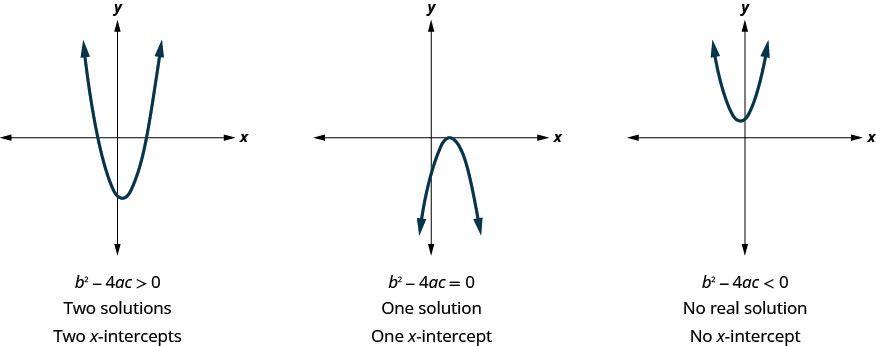
Before you find the values of the x-intercepts, you may want to evaluate the discriminant so you know how many solutions to expect.
Try it!
Find the intercepts of the parabola for the function f(x) = 5x2 + x + 4.
Solution (click to reveal)
| Steps | Algebraic |
| Function | [latex]\displaystyle f(x) = 5x^2 + x + 4[/latex] |
| To find the y-intercept, let x = 0, as indicated in red. | [latex]\displaystyle f(0) = 5.({\color{myred1}0})^2 + {\color{myred1}0} + 4[/latex] |
| Solve for f(x). | [latex]\displaystyle f(0) = 4[/latex] |
| Y-intercept? |
When x = 0, then f(0) = 4. The y-intercept is the point (0, 4). |
| Function - to find the x-intercept | [latex]\displaystyle f(x) = 5x^2 + x + 4[/latex] |
| To find the x-intercept, let f(x) = 0 and solve for x. | [latex]\displaystyle 0 = 5x^2 + x + 4[/latex] |
| Find the value of the discriminant to predict the number of solutions which is also the number of x-intercepts. |
b2 − 4ac 12 − 4 · 5 · 4 1 − 80 −79 |
| X-intercept? | Since the value of the discriminant is negative, there is no real solution to the equation. There are no x-intercepts. |
Find the intercepts of the parabola whose function is f(x) = 3x2 + 4x + 4.
Solution (click to reveal)
y-intercept: (0, 4) no x-intercept
Graph Quadratic Functions Using Properties
Now we have all the pieces we need in order to graph a quadratic function. We just need to put them together. In the next example we will see how to do this.
Try it! - How to Graph a Quadratic Function Using Properties
Graph f(x) = x2 − 6x + 8 by using its properties.
Solution (click to reveal)
| Steps | Algebraic |
| Step 1. Determine whether the parabola opens upward or downward: Look at a in the equation. [latex]\displaystyle f(x) = x^2 - 6x + 8[/latex] | [latex]\begin{gather*} f(x) = x^2 - 6x + 8\\ {\color{myred1}a = 1, b = -6, c = 8}\\\end{gather*} [/latex]
Since a is positive, the parabola opens upward. |
| Step 2. Find axis of symmetry: The axis of symmetry is the line [latex]\displaystyle x = -\frac{b}{2a}[/latex] | [latex]\begin{align*} x &= -\frac{b}{2a} \\ x &= -\frac{(-6)}{2 . 1} \\ x &= 3\end{align*}[/latex]
The axis of symmetry is the line x = 3 |
| Step 3. Find the vertex: The vertex is on the axis of symmetry. So substitute x = 3. | [latex]\begin{align*} f(x) &= x^2 -6x +8 \\ f(3) &= {\color{myred1}(3)}^2 - 6. {\color{myred1}(3)} + 8 \\ f(3) &= -1\end{align*}[/latex]
The vertex is (3, -1). |
| Step 4. Find the y-intercept. Find the point symmetric to the y-intercept across the axis of symmetry:
We find f(0). We use the axis of symmetry to find a point symmetric to the y-intercept. The y-intercept is 3 unit left of the axis of symmetry, x= 3. A point 3 unit to the right of the axis of symmetry has x = 6. |
[latex]\begin{align*} f(x) &= x^2 - 6x + 8 \\ f(0) & = {\color{myred1}(0)}^2 -6.{\color{myred1}0} + 8 \\ f(0) &= 8\end{align*}[/latex]
The y-intercept is (0, 8). Point symmetric to y-intercept: The point is (6, 8). |
| Step 5. Find the x-intercept and find additional points if needed:
We solve f(x) = 0, by factoring. |
[latex]\begin{align*} f(x) &= x^2 - 6x + 8 \\ 0 &= x^2 - 6x + 8 \\ 0 &= (x-2)(x-4) \\ x &= 2 \\ x &=4\end{align*}[/latex]
The x-intercepts are (2, 0) and (4, 0). |
| Step 6. Graph the parabola:
We graph the vertex, intercepts and the point symmetric to the y-intercept. W connect these 5 points to sketch the parabolas. |
 |
Graph f(x) = x2 − 8x + 12 by using its properties.
Solution (click to reveal)
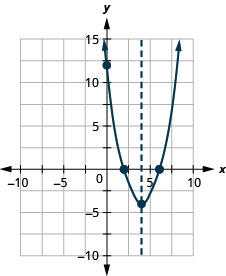
How to graph a quadratic function using properties.
- Determine whether the parabola opens upward or downward.
- Find the equation of the axis of symmetry.
- Find the vertex.
- Find the y-intercept. Find the point symmetric to the y-intercept across the axis of symmetry.
- Find the x-intercepts. Find additional points if needed.
- Graph the parabola.
We were able to find the x-intercepts in a previous example by factoring. We find the x-intercepts in the next example by factoring too.
Try it!
Graph f(x) = -x2 + 6x − 9 by using its properties.
Solution (click to reveal)
| Steps | Algebraic |
| Original Function | [latex]\begin{align*} f(x) &= {\color{myred1}ax^2 + bx + c}\\ f(x) &= -x^2 + 6x - 9 \end{align*}[/latex] |
| Since a = −1, the parabola opens downward. | |
| To find the equation of the axis of symmetry, use [latex]\displaystyle x = -\frac{b}{2a}[/latex] | [latex]\displaystyle x= -\frac{b}{2a}[/latex] |
| Plug-in the values for a and b | [latex]\displaystyle x= -\frac{6}{2(-1)}[/latex] |
| Simplify | [latex]\displaystyle x= 3[/latex] |
| Solution of vertex and axis of symmetry | The axis of symmetry is x = 3 and the vertex is on the line x = 3. |
| Graph the line | 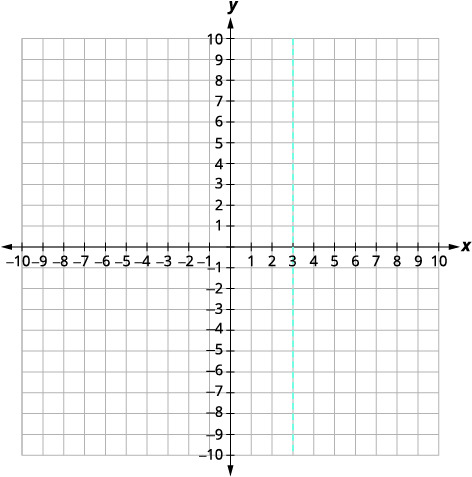 |
| Original Function | [latex]\displaystyle f(x) = -x^2 + 6x - 9[/latex] |
| Find f(3), as indicated in red. | [latex]\displaystyle f(3) = 5. {\color{myred1}3}^2 + 6.{\color{myred1}3} - 9[/latex] |
| Simplify | [latex]\begin{align*} f(3) &= -9 + 18 - 9 \\ f(3) &= 0 \end{align*}[/latex] |
| Solution | The vertex is (3, 0) |
| Graph the Vertex. | 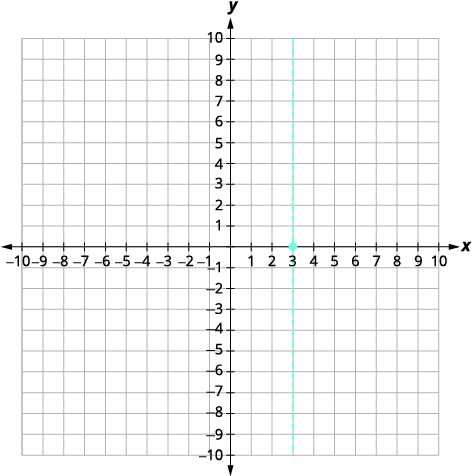 |
| The y-intercept occurs when x = 0. Find f(0). | [latex]\displaystyle f(x) = -x^2 + 6x - 9[/latex] |
| Substitute x = 0, as indicated in red. | [latex]\displaystyle f(0) = 5. {\color{myred1}0}^2 + 6.{\color{myred1}0} - 9[/latex] |
| Simplify | [latex]\displaystyle f(0) = - 9[/latex] |
| Solution | The y-intercept is (0,−9). |
| The point (0, −9) is three units to the left of the line of symmetry. The point three units to the right of the line of symmetry is (6, −9) and the point symmetric to the y-intercept. | 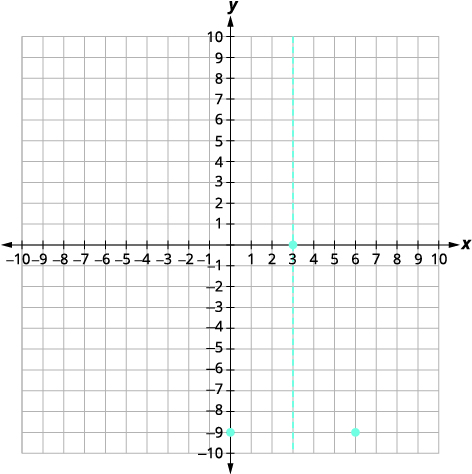 |
| The x-intercept occurs when f(x) = 0. | [latex]\displaystyle f(x) = -x^2 + 6x - 9[/latex] |
| Find f(x) = 0, as indicated in red. | [latex]\displaystyle {\color{myred1}0} = -x^2 + 6x - 9[/latex] |
| Factor the GCF. | [latex]\displaystyle 0 = (-x^2 + 6x - 9)[/latex] |
| Factor the trinomial. | [latex]\displaystyle 0 = -(x - 3)^2 [/latex] |
| Solve for x. | [latex]\displaystyle x = 3 [/latex] |
| Connect the points to graph the parabola. | 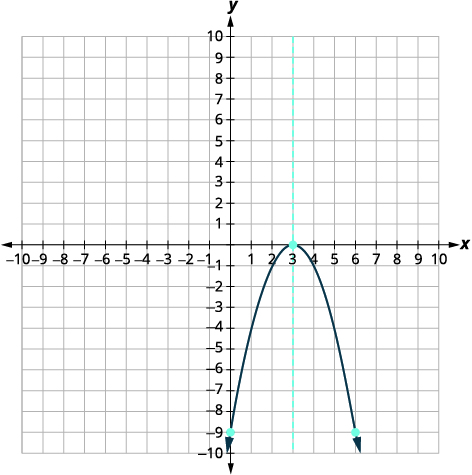 |
Graph f(x) = 3x2 + 12x − 12 by using its properties.
Solution (click to reveal)
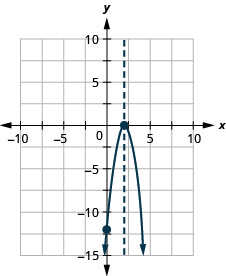
For the graph of f(x) = −x2 + 6x − 9, the vertex and the x-intercept were the same point. Remember how the discriminant determines the number of solutions of a quadratic equation? The discriminant of the equation 0 = −x2 + 6x − 9 is 0, so there is only one solution. That means there is only one x-intercept, and it is the vertex of the parabola.
How many x-intercepts would you expect to see on the graph of f(x) = x2 + 4x + 5?
Try it!
Graph f(x) = x2 + 4x + 5 by using its properties.
Solution (click to reveal)
| Steps | Algebraic |
| Original Function | [latex]\begin{align*} f(x) &= {\color{myred1}ax^2 + bx + c} \\ f(x) &= x^2 + 4x + 5 \end{align*}[/latex] |
| Since a = 1, the parabola opens upward. | |
| To find the equation of the axis of symmetry, use [latex]\displaystyle x = -\frac{b}{2a}[/latex] | [latex]\displaystyle x= -\frac{b}{2a}[/latex] |
| Plug-in the values for a and b | [latex]\displaystyle x= -\frac{4}{2(1)}[/latex] |
| Solution of vertex and axis of symmetry | [latex]\displaystyle x= -2[/latex] |
| Graph the line | 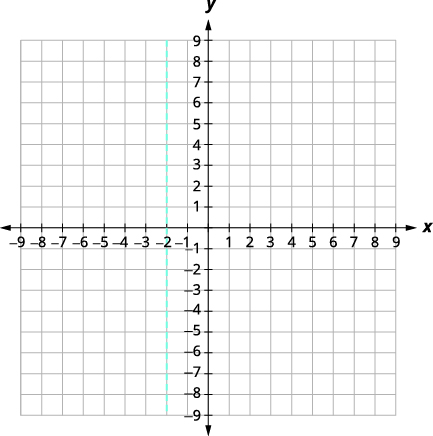 |
| Find f(x) when x = −2. | [latex]\displaystyle f(x) = x^2 + 4x + 5[/latex] |
| Plug-in x = −2, as indicated in red. | [latex]\displaystyle f(-2) = {\color{myred1}(-2)}^2 + 4.{\color{myred1}(-2)} + 5[/latex] |
| Simplify | [latex]\begin{align*} f(-2) &= 4 - 8 + 5 \\ f(-2) &= 1 \end{align*}[/latex] |
| Solution | The vertex is (−2, 1). |
| Graph the Vertex. | 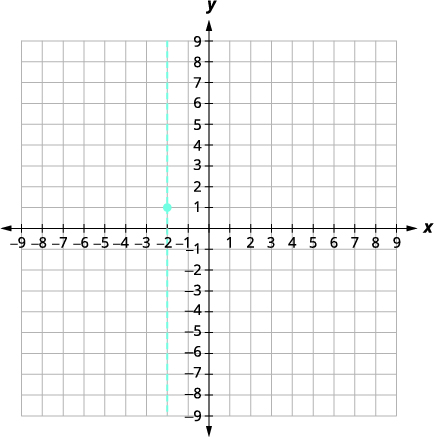 |
| The y-intercept occurs when x = 0. Find f(0). | [latex]\displaystyle f(x) = x^2 + 4x + 5[/latex] |
| Substitute x = 0. | [latex]\displaystyle f(0) = 5[/latex] |
| Solution | The y-intercept is (0, 5). |
| The point (−4, 5) is two units to the left of the line of symmetry.
The point two units to the right of the line of symmetry is (0, 5), point symmetric to the y-intercept |
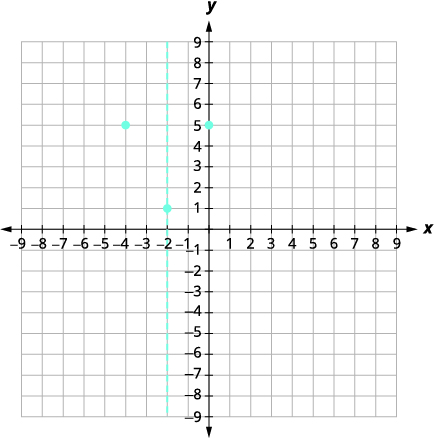 |
| The x-intercept occurs when f(x) = 0. Find f(x) = 0, as indicated in red. | [latex]\displaystyle {\color{myred1}0} = x^2 + 4x + 5[/latex] |
| Test the discriminant. | [latex]\displaystyle D = b^2 - 4ac[/latex] |
| Simplify | [latex]\begin{align*} D &= 4^2 - 4 . 1 . 5 \\ D &= 16 - 20 \\ D &= -4\end{align*}[/latex] |
| X-intercept? | Since the value of the discriminant is negative, there is no real solution and so no x-intercept. |
| Connect the points to graph the parabola. You may want to choose two more points for greater accuracy. | 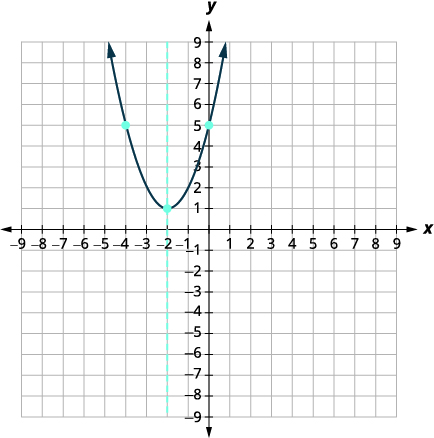 |
Graph f(x) = −3x2 − 6x − 4 by using its properties.
Solution (click to reveal)
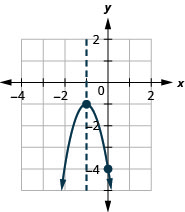
Finding the y-intercept by finding f(0) is easy, isn’t it? Sometimes we need to use the Quadratic Formula to find the x-intercepts.
Graph f(x) = 2x2 − 4x − 3 by using its properties.
Solution (click to reveal)
| Steps | Algebraic |
| Function | [latex]\begin{align*} f(x) &= {\color{myred1}ax^2 + bx + c }\\ f(x) &= 2x^2 - 4x - 3 \end{align*}[/latex] |
| Since a = 2, the parabola opens upward. | |
| To find the equation of the axis of symmetry, use [latex]\displaystyle x = -\frac{b}{2a}[/latex] | [latex]\displaystyle x= -\frac{b}{2a}[/latex] |
| Plug-in the values and Simplify | [latex]\displaystyle x= -\frac{-4}{2 . 2}[/latex] |
| The equation of the axis of symmetry is x = 1. | [latex]\displaystyle x= 1[/latex] |
| Original Function: The vertex is on the line x = 1. | [latex]\displaystyle f(x) = 2x^2 - 4x - 3[/latex] |
| Find f(1), as indicated in red. | [latex]\displaystyle f(1) = 2({\color{myred1}1})^2 - 4.{\color{myred1}1} - 3[/latex] |
| Simplify | [latex]\displaystyle f(1) = 2 - 4 - 3[/latex] |
| The vertex is (1, −5). | [latex]\displaystyle f(1) = -5[/latex] |
| Original Function: The y-intercept occurs when x = 0. | [latex]\displaystyle f(x) = 2x^2 - 4x - 3[/latex] |
| Find f(0), as indicated in red. | [latex]\displaystyle {\color{myred1}0} = 2.{\color{myred1}0}^2 - 4.{\color{myred1}0} - 3[/latex] |
| Simplify. The y-intercept is (0, −3). | [latex]\displaystyle f(0) = - 3[/latex] |
| The point (0, −3) is one unit to the left of the line of symmetry. The point one unit to the right of the line of symmetry is (2, −3). | Point symmetric to the y-intercept is (2, −3). |
| The x-intercept occurs when y = 0. | [latex]\displaystyle f(x) = 2x^2 - 4x - 3[/latex] |
| Find f(x) = 0, as indicated in red. | [latex]\displaystyle {\color{myred1}0} = 2x^2 - 4x - 3[/latex] |
| Use the Quadratic Formula. | [latex]\displaystyle x= \frac{-b\pm\sqrt{b^2−-4ac}}{2a}[/latex] |
| Substitute in the values of a, b and c. | [latex]\displaystyle x= \frac{-(-4)\pm\sqrt{(-4)^2−-4(2)(3)}}{2(2)}[/latex] |
| Simplify. | [latex]\displaystyle x= \frac{4\pm\sqrt{16 + 24}}{4}[/latex] |
| Simplify inside the radical. | [latex]\displaystyle x= \frac{4\pm\sqrt{40}}{4}[/latex] |
| Simplify the radical. | [latex]\displaystyle x= \frac{4\pm 2\sqrt{10}}{4}[/latex] |
| Factor the GCF. | [latex]\displaystyle x= \frac{2(2\pm\sqrt{10})}{4}[/latex] |
| Remove common factors. | [latex]\displaystyle x= \frac{2\pm\sqrt{10}}{2}[/latex] |
| Write as two equations. | [latex]\begin{align*} x &= \frac{2 + \sqrt{10}}{2} \\ x &= \frac{2 - \sqrt{10}}{2} \end{align*}[/latex] |
| Approximate the values. | [latex]\begin{align*} x &\approx 2.5 \\ x &\approx -0.6 \end{align*}[/latex] |
| Solution | The approximate values of the x-intercepts are (2.5, 0) and (−0.6, 0). |
| Graph the parabola using the points found. | 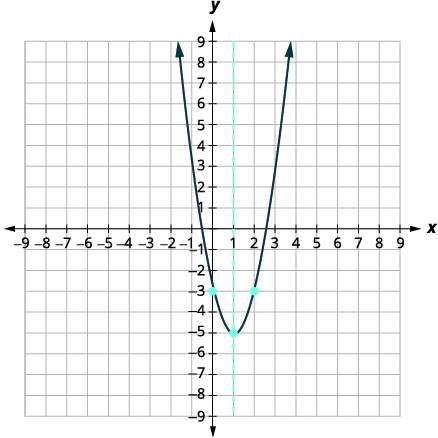 |
Graph f(x) = −3x2 − 6x + 5 by using its properties.
Solution (click to reveal)
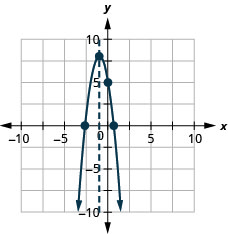
Solve Maximum and Minimum Applications
Knowing that the vertex of a parabola is the lowest or highest point of the parabola gives us an easy way to determine the minimum or maximum value of a quadratic function. The y-coordinate of the vertex is the minimum value of a parabola that opens upward. It is the maximum value of a parabola that opens downward. See the graphs below.
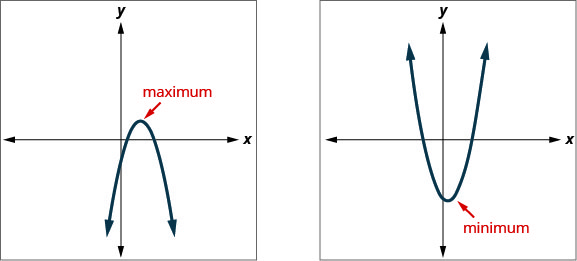
Minimum or Maximum Values of a Quadratic Function
The y-coordinate of the vertex of the graph of a quadratic function is the
- minimum value of the quadratic equation if the parabola opens upward.
- maximum value of the quadratic equation if the parabola opens downward.
So
[latex]\displaystyle f\left(\frac{-b}{2a}\right) [/latex]
is the Minimum or Maximum depending on the parabola's orientation.
Try it!
Find the minimum or maximum value of the quadratic function
f(x) = x2 + 2x − 8.
Solution (click to reveal)
| Steps | Algebraic |
| Function | [latex]\displaystyle f(x) = x^2 + 2x - 8[/latex] |
| Since a is positive, the parabola opens upward. |
The quadratic equation has a minimum. |
| Find the equation of the axis of symmetry. | [latex]\displaystyle x= -\frac{b}{2a}[/latex] |
| Plug-in the values | [latex]\displaystyle x= -\frac{2}{2 . 1}[/latex] |
| Solution: The equation of the axis of symmetry is x = −1. | [latex]\displaystyle x= -1[/latex] |
| The vertex is on the line x=−1. | [latex]\displaystyle f(x) = x^2 + 2x - 8[/latex] |
| Find f(−1), as indicated in red. | [latex]\displaystyle f(-1) = {\color{myred1}(-1)}^2 + 2{\color{myred1}(-1)} - 8[/latex] |
| Simplify | [latex]\displaystyle f(-1) = 1 - 2 - 8[/latex] |
| Solution: The vertex is (−1, −9). | [latex]\displaystyle f(-1) = - 9[/latex] |
| Since the parabola has a minimum, the y-coordinate of the vertex is the minimum y-value of the quadratic equation. |
The minimum value of the quadratic is −9 and it occurs when x = −1. |
| Show the graph to verify the result. | 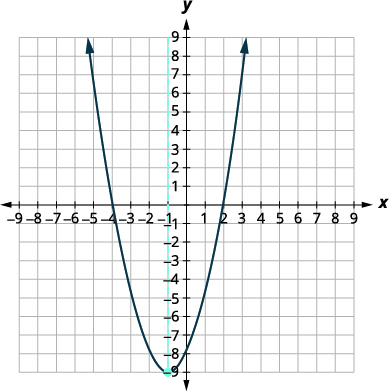 |
Find the maximum or minimum value of the quadratic function
f(x) = x2 − 8x + 12.
Solution (click to reveal)
The minimum value of the quadratic function is −4 and it occurs when x = 4.
Find the maximum or minimum value of the quadratic function
f(x) = −4x2 + 16x − 11.
Solution (click to reveal)
The maximum value of the quadratic function is 5 and it occurs when x = 2.
Access these online resources for additional instruction and practice with graphing quadratic functions using properties.
Key Concepts
- Parabola Orientation
- For the graph of the quadratic function f(x) = ax2 + bx +c, if
- a > 0, the parabola opens upward.
- a < 0, the parabola opens downward.
- For the graph of the quadratic function f(x) = ax2 + bx +c, if
- Axis of Symmetry and Vertex of a Parabola: The graph of the function f(x) = ax2 + bx +c is a parabola where:
- the axis of symmetry is the vertical line [latex]\displaystyle x = -\frac{b}{2a}[/latex].
- the vertex is a point on the axis of symmetry, so its x-coordinate is [latex]\displaystyle -\frac{b}{2a}[/latex].
- the y-coordinate of the vertex is found by substituting [latex]\displaystyle x = -\frac{b}{2a}[/latex] into the quadratic equation.
- Find the Intercepts of a Parabola
- To find the intercepts of a parabola whose function is f(x) = ax2 + bx + c:
y-intercept x-intercepts Let x = 0 and solve for f(x) Let f(x) = 0 and solve for x
- To find the intercepts of a parabola whose function is f(x) = ax2 + bx + c:
- How to graph a quadratic function using properties.
- Determine whether the parabola opens upward or downward.
- Find the equation of the axis of symmetry.
- Find the vertex.
- Find the y-intercept. Find the point symmetric to the y-intercept across the axis of symmetry.
- Find the x-intercepts. Find additional points if needed.
- Graph the parabola.
- Minimum or Maximum Values of a Quadratic Equation
- The y-coordinate of the vertex of the graph of a quadratic equation is the
- minimum value of the quadratic equation if the parabola opens upward.
- maximum value of the quadratic equation if the parabola opens downward.



